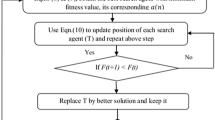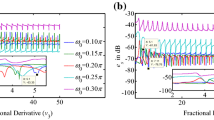Abstract
In this article, an optimal design of two-dimensional finite impulse response (2D FIR) filter with quadrantally even symmetric impulse response using fractional derivative constraints (FDCs) is presented. Firstly, design problem of 2D FIR filter is formulated as an optimization problem. Then, FDCs are imposed over the integral absolute error for designing of the quadrantally even symmetric impulse response filter. The optimized FDCs are applied over the prescribed frequency points. Next, the optimized filter impulse response coefficients are computed using a hybrid optimization technique, called hybrid particle swarm optimization and gravitational search algorithm (HPSO-GSA). Further, FDC values are also optimized such that flat passband and stopband frequency response is achieved and the absolute \(L_1\)-error is minimized. Finally, four design examples of 2D low-pass, high-pass, band-pass and band-stop filters are demonstrated to justify the design accuracy in terms of passband error, stopband error, maximum passband ripple, minimum stopband attenuation and execution time. Simulation results have been compared with the other optimization algorithms, such as real-coded genetic algorithm, particle swarm optimization and gravitational search algorithm. It is observed that HPSO-GSA gives improved results for 2D FIR-FDC filter design problem. In comparison with other existing techniques of 2D FIR filter design, the proposed method shows improved design accuracy and flexibility with varying values of FDCs.












Similar content being viewed by others
References
A. Aggarwal, M. Kumar, T.K. Rawat, \(L_1\) error criterion based optimal FIR filters, in Annual IEEE India Conference INDICON (2014), pp. 1–6
A. Aggarwal, M. Kumar, T.K. Rawat, D.K. Upadhyay, An \(L_1\)-method: application to digital symmetric type-II FIR filter design, in Intelligent Systems Technologies and Applications (Springer International Publishing, Switzerland, 2016), pp. 335–343
A. Aggarwal, T.K. Rawat, M. Kumar, D.K. Upadhyay, Optimal design of FIR high pass filter based on \(L_1\) error approximation using real coded genetic algorithm. Int. J. Eng. Sci. Technol. 18(4), 594–602 (2015)
M. Azarmehr, M. Ahmadi, Low-power finite impulse response (FIR) filter design using two-dimensional logarithmic number system (2DLNS) representations. Circuits Syst. Signal Process. 31(6), 2075–2091 (2012)
K. Baderia, A. Kumar, G.K. Singh, Hybrid method for designing digital FIR filters based on fractional derivative constraints. ISA Trans. (2015). doi:10.1016/j.isatra.2015.05.015
I. Bankman, Handbook of Medical Image Processing and Analysis (Academic Press, New York, 2008)
K. Boudjelaba, F. Ros, D. Chikouche, An advanced genetic algorithm for designing 2-D FIR filters, in IEEE Pacific Rim Conference on Communications, Computers and Signal Processing (2011), pp. 60–65
K. Boudjelaba, F. Ros, D. Chikouche, Adaptive genetic algorithm-based approach to improve the synthesis of two-dimensional finite impulse response filters. IET Signal Process. 8(5), 429–446 (2014)
S. Das, A. Konar, A swarm intelligence approach to the synthesis of two-dimensional IIR filters. Eng. Appl. Artif. Intell. 20(8), 1086–1096 (2007)
S. Das, Functional Fractional Calculus for System Identification and Controls (Springer, Berlin, 2008)
S. Dhabal, P. Venkateswaran, Two-dimensional IIR filter design using simulated annealing based particle swarm optimization. J. Optim. (2014). doi:10.1155/2014/239721
A. Gouze, M. Antonini, M. Barlaud, Quincunx lifting scheme for lossy image compression, in Proceedings of International Conference on Image Processing, vol. 1 (2000), pp. 665–668
L.D. Grossmann, Y.C. Eldar, An \(L_1\)-method for the design of linear-phase FIR digital filters. IEEE Trans. Signal Process. 55(11), 5253–5266 (2007)
T.K. Gunaratne, L.T. Bruton, Adaptive complex-coefficient 2D FIR trapezoidal filters for broadband beamforming in cognitive radio systems. Circuits Syst. Signal Process. 30(3), 587–608 (2011)
J.H. Holland, Adaptation in Natural and Artificial Systems (University of Michigan Press, Ann Arbor, 1975)
S. Jiang, Z. Ji, Y. Shen, A novel hybrid particle swarm optimization and gravitational search algorithm for solving economic emission load dispatch problems with various practical constraints. Int. J. Electr. Power Energy Syst. 55, 628–644 (2014)
S. Jiang, Y. Wang, Z. Ji, A new design method for adaptive IIR system identification using hybrid particle swarm optimization and gravitational search algorithm. Nonlinear Dyn. 79(4), 2553–2576 (2015)
T. Kaczorek, Two-Dimensional Linear System (Springer, Berlin, 1985)
J. Kennedy, R. Eberhart, Particle swarm optimization, in Proceedings of IEEE Interernational Conference on Neural Network vol. 4, (1995), pp. 1942–1948
R.K. Khadanga, J.K. Satapathy, Time delay approach for PSS and SSSC based coordinated controller design using hybrid PSOGSA algorithm. Int. J. Electr. Power Energy Syst. 71, 262–273 (2015)
S. Kockanat, N. Karaboga, The design approaches of two-dimensional digital filters based on metaheuristic optimization algorithms: a review of the literature. Artif. Intell. Rev. 44(2), 265–287 (2015)
S. Kockanat, N. Karaboga, A novel 2D-ABC adaptive filter algorithm: a comparative study. Digit. Signal Process. 40, 140–153 (2015)
B. Kuldeep, V.K. Singh, A. Kumar, G.K. Singh, Design of two-channel filter bank using nature inspired optimization based fractional derivative constraints. ISA Trans. 54, 101–116 (2015)
B. Kuldeep, A. Kumar, G.K. Singh, Design of multi-channel cosine-modulated filter bank based on fractional derivative constraints using cuckoo search algorithm. Circuits Syst. Signal Process. 34(10), 3325–3351 (2015)
M. Kumar, T.K. Rawat, Optimal fractional delay-IIR filter design using cuckoo search algorithm. ISA Trans. 59, 39–54 (2015)
M. Kumar, T.K. Rawat, Optimal design of FIR fractional order differentiator using cuckoo search algorithm. Expert Syst. Appl. 42(7), 3433–3449 (2015)
B. Lashgari, L.M. Silverman, Recursive estimation of two-dimensional processes with application to image processing. Circuits Syst. Signal Process. 5(2), 211–226 (1986)
H.C. Lu, S.T. Tzeng, Design of two-dimensional FIR digital filters for sampling structure conversion by genetic algorithm approach. Signal Process. 80(8), 1445–1458 (2000)
L. Ma, Y. Wang, T. Tan, Iris recognition using circular symmetric filters, in Proceedings of 16th International Conference on Pattern Recognition, vol. 2 (IEEE, 2002), pp. 414–417
N.E. Mastorakis, I.F. Gonos, M.N.S. Swamy, Design of two-dimensional recursive filters using genetic algorithms. IEEE Trans. Circuits Syst. I Fundam. Theory Appl. 50(5), 634–639 (2003)
K.S. Miller, B. Ross, An Introduction to the Fractional Calculus and Fractional Differential Equations (Wiley, New York, 1993)
S. Mirjalili, S.Z.M. Hashim, A new hybrid PSOGSA algorithm for function optimization, in IEEE International Conference on Computer and Information Application (2010), pp. 374–377
V.M. Mladenov, N.E. Mastorakis, Design of two-dimensional recursive filters by using neural networks. IEEE Trans. Neural Netw. 12(3), 585–590 (2001)
M. Nakamoto, T. Hinamoto, S. Ohno, Noise reduction in two-dimensional recursive digital filters with discrete optimized error feedback coefficients. Circuits Syst. Signal Process. 31(4), 1359–1378 (2012)
R. Panda, M.K. Naik, N. Mishra, Design of two-dimensional recursive filters using bacteria foraging optimization, in Proceedings of IEEE International Conference on Computational Intelligence. Singapore (2013), pp. 188–193
S.C. Pei, J.J. Shyu, Design of 2D FIR digital filters by McClellan transformation and least squares eigencontour mapping. IEEE Trans. Circuits Syst. II: Analog Digit. Signal Process. 40(9), 546–555 (1993)
E. Rashedi, H. Nezamabadi-pour, S. Saryazdi, GSA: a gravitational search algorithm. Inf. Sci. 179(13), 2232–2248 (2009)
S.K. Sarangi, R. Panda, M. Dash, Design of 1-D and 2-D recursive filters using crossover bacterial foraging and cuckoo search techniques. Eng. Appl. Artif. Intell. 34, 109–121 (2014)
D. Serhat, N. Yorukeren, I.H. Altas, A novel modified hybrid PSOGSA based on fuzzy logic for non-convex economic dispatch problem with valve-point effect. Int. J. Electr. Power Energy Syst. 64, 121–135 (2015)
J.J. Shyu, S.C. Pei, Lagrange multiplier approach to the design of two-dimensional FIR digital filters for sampling structure conversion. IEEE Trans. Signal Process. 42(10), 2884–2886 (1994)
D.B. Tay, N.G. Kingsbury, Flexible design of multidimensional perfect reconstruction FIR 2-band filters using transformations of variables. IEEE Trans. Image Process. 2(4), 466–480 (1993)
J.T. Tsai, W.H. Ho, J.H. Chou, Design of two-dimensional recursive filters by using Taguchi-based immune algorithm. IET Signal Process. 2(2), 110–117 (2008)
J.T. Tsai, W.H. Ho, J.H. Chou, Design of two-dimensional IIR digital structure-specified filters by using an improved genetic algorithm. Expert Syst. Appl. 36(3), 6928–6934 (2009)
C.C. Tseng, S.L. Lee, Design of linear phase FIR filters using fractional derivative constraints. Signal Process. 92(5), 1317–1327 (2012)
C.C. Tseng, S.L. Lee, Designs of two-dimensional linear phase FIR filters using fractional derivative constraints. Signal Process. 93(5), 1141–1151 (2013)
C.C. Tseng, S.L. Lee, Designs of fractional derivative constrained 1-D and 2-D FIR filters in the complex domain. Signal Process. 95, 111–125 (2014)
S.G. Tzafestas, Multidimensional Systems, Techniques and Applications (Marcel Dekker, New York, 1986)
D.J. Verschuur, Seismic Multiple Removal Techniques: Past, Present and Future (EAGE Publications, Netherlands, 2006)
T. Williams, M. Ahmadi, W.C. Miller, Design of 2D FIR and IIR digital filters with canonical signed digit coefficients using singular value decomposition and genetic algorithms. Circuits Syst. Signal Process. 26(1), 69–89 (2007)
Author information
Authors and Affiliations
Corresponding author
Rights and permissions
About this article
Cite this article
Aggarwal, A., Kumar, M., Rawat, T.K. et al. Optimal Design of 2D FIR Filters with Quadrantally Symmetric Properties Using Fractional Derivative Constraints. Circuits Syst Signal Process 35, 2213–2257 (2016). https://doi.org/10.1007/s00034-016-0283-x
Received:
Revised:
Accepted:
Published:
Issue Date:
DOI: https://doi.org/10.1007/s00034-016-0283-x




